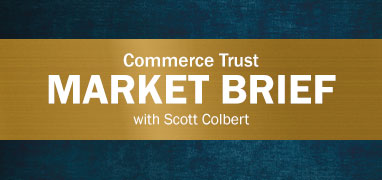Outlook
2026 COMMERCE TRUST ECONOMIC AND MARKET OUTLOOK
Markets Defy Economic Tension
Perspectives and outlook on the markets and economy from the Commerce Trust investment management team.
Read the 2026 Commerce Trust Economic and Market Outlook
Market Brief
Market Questions Timing of Next Fed Interest Rate Cut and AI Momentum
In the latest Commerce Trust Market Brief video, Scott Colbert, Chief Economist and Director of Fixed Income Management, provides his perspective on what factors may be behind this recent modest market correction.
Podcast
2025 Market Recap and Year-End Portfolio Management Strategies
In a new episode of the Conversations with Commerce Trust podcast, Chief Investment Officer and host David Hagee is joined by Kelly Jernigan, Director of Family Wealth Strategy, Commerce Trust, to discuss 2025 stock market performance, underlying tensions in the economy and markets, and year-end strategies for asset allocation and tax-efficient investing.
Look at the Markets
Commerce Trust Look at the Markets
Quarterly insights into economic and market trends from David Hagee, Chief Investment Officer, Commerce Trust, and our investment team leaders. F O U R T H Q U A R T E R 2 0 2 5
Market Brief
Stock Market Beats Expectations as Inflation Holds Steady
In the latest Commerce Trust Market Brief video, Scott Colbert, Chief Economist and Director of Fixed Income Management, provides his latest perspective on the economic trends supporting continuing stock market and fixed income performance.
Magazine
Encompass by Commerce Trust
Winter 2025
For high-net-worth families, the most lasting measure of your legacy can be found in how thoughtfully assets are transferred to heirs and to philanthropic beneficiaries.
Commentary
Earnings Landscape: Downward Progression,
but Still Growth
Challenging market dynamics impacted earnings, but there is still room for growth over 2024.
Our Insights
The advisors, specialists and thought-leaders at Commerce Trust dive into the state of the economy and the financial markets — providing valuable news, perspectives and advice you can use to your advantage.




